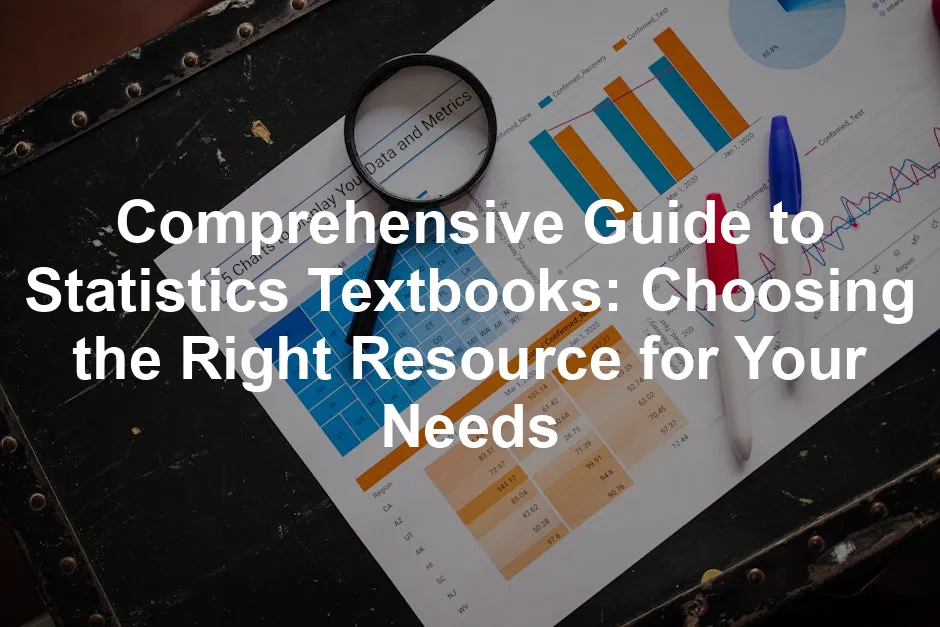Introduction
Statistics is the unsung hero of today’s data-driven universe. It’s everywhere, from the stock market to sports analytics. Understanding statistics helps you decipher complex data, make informed decisions, and predict trends like a fortune teller—but with numbers.
Textbooks play a crucial role in mastering these concepts. They serve as the guidebooks on your statistical adventure, whether you’re a student, a professional sharpening your skills, or a curious mind wanting to dive into data.
With a plethora of textbooks available, there’s something for everyone. Texts range from the whimsical to the rigorous, catering to diverse learning styles. Some textbooks are as approachable as a friendly chat over coffee, while others might feel like a dense fog of equations. Your choice depends on your level of expertise and what you aim to achieve.
The beauty of statistics lies in its versatility. You could study it for academic purposes, professional development, or simply for personal interest. Regardless, the right textbook can illuminate the path to statistical enlightenment, making complex concepts accessible and engaging. So, whether you’re crunching numbers for a research project or just trying to make sense of the latest Twitter poll, there’s a textbook out there just waiting for you to crack it open. an introduction to statistical learning with python book length

The right textbook can illuminate the path to statistical enlightenment. an introduction to statistical learning with python book length
The Importance of Statistics Education
Understanding Statistics
Statistics is the science of collecting, analyzing, interpreting, and presenting data. It’s like the secret sauce that adds flavor to raw numbers. Why is it essential, you ask? Well, statistics is the backbone of various fields. In economics, it helps analyze market trends. In healthcare, it informs treatment effectiveness. Social sciences rely on it to understand human behavior. And in data science? It’s the language that data speaks.
Common concepts include probability, data analysis, and inferential statistics. Probability is the art of predicting outcomes. Data analysis transforms raw data into meaningful insights. Inferential statistics allows us to draw conclusions about a population based on sample data. Together, these concepts form the foundation of statistical literacy, empowering you to tackle real-world problems with confidence. mendelian genetics probability pedigrees and chi-square statistics

Common concepts like probability and inferential statistics are crucial for understanding data. mendelian genetics probability pedigrees and chi-square statistics
Understanding statistics equips you with critical skills. It enhances your ability to think critically and interpret data accurately. With these skills, you’re not just consuming information; you’re analyzing it, questioning it, and making informed decisions. Whether you’re evaluating a new medication’s effectiveness or interpreting survey results, statistical knowledge is your trusty compass.
In a world overflowing with data, statistical education isn’t just a nice-to-have. It’s a necessity. So, buckle up! The journey through the realm of statistics is not only enlightening but also incredibly rewarding.
Benefits of Learning Statistics
Learning statistics is like acquiring a superpower. It arms you with critical skills that go beyond numbers. First, let’s talk about critical thinking. Statistics trains your brain to analyze data and discern patterns. You start questioning everything—maybe even why your neighbor’s cat stares at you so intently.
Data interpretation is another gem in your statistics toolkit. You learn how to sift through mountains of data and extract insights. Imagine being able to interpret survey results or market trends with the confidence of a data wizard. That’s not just useful; it’s downright impressive!
Now, let’s sprinkle in some informed decision-making. With statistical knowledge, you can make choices grounded in evidence rather than gut feelings. For example, if you’re in marketing, you’ll analyze consumer data to craft targeted campaigns. Or, if you’re in healthcare, you can evaluate treatment effectiveness. It’s like being the Sherlock Holmes of decision-making; you have the data to back up your hunches.
In your personal life, statistics can help you assess risks. Whether it’s budgeting for a vacation or investing in stocks, statistical literacy equips you to make smarter choices. You’ll be able to weigh pros and cons like a seasoned pro.
Ultimately, mastering statistics can significantly impact your career trajectory. Many fields, such as finance, healthcare, and technology, demand statistical skills. Employers love candidates who can turn data into actionable insights. So, whether you’re crunching numbers in a boardroom or analyzing your fitness app data, the benefits of learning statistics are undeniable.
With these skills, you’re not just another cog in the machine. You become a data-savvy individual ready to tackle challenges head-on. So, gear up and embrace the stats!

Advanced Textbooks
*The Elements of Statistical Learning* by Hastie, Tibshirani, and Friedman
If you’re ready to take statistics to the next level, this book is your golden ticket. It’s not your average textbook; it’s a masterclass in statistical learning. Think of it as the ultimate guide to machine learning, data mining, and predictive analytics. The authors, Hastie, Tibshirani, and Friedman, are rock stars in the statistics world. They blend theory and application seamlessly, making complex concepts digestible.
With exercises that challenge your understanding, this book is ideal for those with a solid mathematical background. Expect to dive into topics like regression, classification, and clustering. And don’t worry; they provide ample real-world examples. It’s perfect for anyone looking to sharpen their skills and impress at the next data science meeting. introduction to statistical learning pdf
This book is a masterclass in statistical learning and a great resource for advanced study. introduction to statistical learning pdf
*Bayesian Statistics* by Peter M. Lee
Bayesian Statistics by Peter M. Lee offers an engaging approach to understanding uncertainty in statistical inference. This book stands out because it introduces the Bayesian perspective, which is all about updating our beliefs with evidence. If you’ve ever felt overwhelmed by traditional statistics, this book will be a breath of fresh air.
Lee explains concepts like prior distributions and posterior probabilities with clarity. The logical flow of topics makes it approachable, even if you’re new to Bayesian methods. Plus, you’ll find practical applications throughout, making it easier to grasp the relevance of the material.
Whether you’re a student or a seasoned statistician, this book will enrich your understanding of statistical reasoning. It’s a must-have for those who want to think critically about data and its implications. the problem with inferential statistics

This book provides a fresh perspective on understanding uncertainty in statistics. the problem with inferential statistics
Open Access Resources
In today’s world, education should be accessible to everyone, and the field of statistics is no exception. Free online textbooks and resources like OpenIntro have made learning statistics easier than ever. These platforms provide high-quality content at no cost, catering to self-learners and students alike.
OpenIntro offers comprehensive materials that cover everything from basic concepts to advanced topics. Their textbooks are designed to be user-friendly, making it easy for anyone to understand statistical principles without shelling out big bucks. If you want to explore more about OpenIntro, check out OpenIntro Statistics.

Moreover, these resources encourage independent study, allowing learners to progress at their own pace. The importance of free material cannot be overstated, especially for those who may not have access to traditional academic resources. So, if you’re eager to learn statistics but short on funds, these open-access resources might be your best bet. Happy learning!
Author Expertise
When it comes to statistics textbooks, the authors make all the difference. Learning from established experts in the field is like having a seasoned guide on a treacherous mountain climb. Their expertise shapes the quality and depth of the material presented. An author’s background, experience, and accolades can significantly influence the clarity and comprehensiveness of the content.
Imagine reading a textbook by someone who’s not only written extensively on the subject but has also conducted groundbreaking research. You gain insights that go beyond mere definitions and formulas. These authors often include real-world examples and anecdotes that can spark your interest and make complex concepts more digestible.
Moreover, a well-respected author brings credibility to their work. When they discuss statistical methods or analysis techniques, you can trust that the information is reliable and relevant. This credibility is essential for students and professionals alike, as it lays a strong foundation for understanding advanced statistical concepts. If you’re looking for a solid option, consider *Statistical Methods for the Social Sciences* by Alan Agresti and Barbara Finlay, available here.
So, when choosing a statistics textbook, don’t just look at the title and the cover. Investigate the author’s credentials. Seek out those who have a proven track record in statistics. After all, learning from the best can elevate your understanding and make your journey through the world of statistics far more engaging and rewarding. agresti statistical methods for the social sciences

Learning from established experts can greatly enhance your understanding of statistics. agresti statistical methods for the social sciences
Alternatives to Traditional Textbooks
Online Courses and MOOCs
In this digital age, online courses and MOOCs (Massive Open Online Courses) have emerged as popular alternatives to traditional textbooks. Platforms like Coursera and edX offer comprehensive courses on statistics that can supplement your learning. No longer do you need to rely solely on textbooks stuffed with jargon. Instead, you can learn through video lectures, interactive quizzes, and community discussions.
Khan Academy is another excellent resource. It provides bite-sized lessons that break down complex statistical concepts into easily digestible chunks. You can learn at your own pace, revisiting topics as necessary. Plus, the engaging format keeps the learning process enjoyable. Many of these courses are free or low-cost, making them accessible to everyone. You might also find *Head First Statistics* by Dawn Griffiths, which offers a fun and engaging way to learn statistics, available here.
These platforms often feature renowned instructors and industry experts. This access to knowledgeable educators can enhance your understanding and provide you with insights that textbooks might miss. You’ll also have opportunities for hands-on experience through practical assignments and projects.

Study Guides and Companion Books
While traditional textbooks are invaluable, integrating study guides and companion books can enhance your learning experience. These resources are designed to complement the primary textbook, providing additional explanations, summaries, and practice problems. They act like a trusty sidekick, ready to assist when the main material feels overwhelming.
Workbooks, in particular, allow you to practice what you’ve learned. They offer exercises that reinforce concepts, helping you apply theories to real-world scenarios. This hands-on approach can solidify your understanding and boost your confidence in applying statistical methods. One excellent workbook option is *Statistics for Dummies*, which simplifies the learning process and is available here.
Companion books often include tips, shortcuts, and alternative explanations that can clarify tricky topics. When you hit a wall with your primary textbook, these resources can provide the breakthrough you need.
In short, combining traditional textbooks with online courses, study guides, and companion books creates a well-rounded learning strategy. This blend ensures that you not only grasp theoretical concepts but also know how to apply them effectively in practical situations.

Conclusion
Selecting the right statistics textbook is crucial for your educational journey. The ideal book should align with your individual needs and learning style. Some learners thrive on detailed explanations, while others prefer concise, straightforward approaches. Understanding your preferences can guide you toward a resource that resonates with you.
As you explore various materials, don’t hesitate to switch if a textbook doesn’t meet your expectations. There’s no one-size-fits-all solution in statistics education. Sometimes, the first choice might feel like trying to fit a square peg in a round hole.
Additionally, consider the plethora of resources available, including online courses and supplementary guides, which can enhance your learning experience. The goal is to build a strong statistical foundation that empowers you to analyze data confidently.
Remember, mastering statistics is not just an academic exercise; it’s a valuable investment in your future. With the right resources, you’ll unlock a world of possibilities, whether for career advancement or personal growth. So, embark on this enlightening journey, and don’t be afraid to mix and match your learning materials until you find the perfect fit!

FAQs
What is the best statistics textbook for beginners?
If you’re just starting your statistics journey, look no further than *Statistics for People Who (Think They) Hate Statistics* by Neil J. Salkind. This book breaks down complex concepts into digestible bites. Another gem is *Introductory Statistics* by Prem S. Mann, which offers clear explanations and real-life examples. Both are fantastic choices for friendly, approachable learning.
Are there any free statistics textbooks available?
Absolutely! Open access resources are a treasure trove for self-learners. Check out *Introduction to Modern Statistics* by Mine Çetinkaya-Rundel and Johanna Hardin, available through the OpenIntro project. Another great option is *Introductory Statistics* from OpenStax, which covers essential concepts without costing you a dime. These resources are perfect for anyone on a budget!
How can I study statistics effectively?
Combine your textbooks with practical applications. Start by reading a chapter, then tackle related exercises to reinforce your understanding. Don’t forget to use real-world data for analysis. Websites like Kaggle offer datasets to play with. And remember, taking breaks can enhance retention—your brain needs some downtime too!
What are the differences between introductory and advanced statistics textbooks?
Introductory textbooks focus on fundamental concepts, providing a solid foundation. They use simple language and plenty of examples. On the other hand, advanced textbooks dive deeper into theory, often requiring a strong mathematical background. Expect complex topics like multivariate analysis and Bayesian statistics in these texts, designed for those ready to tackle the heavy lifting.
Is it better to learn statistics online or through textbooks?
Both methods have their perks! Textbooks offer structured learning and depth, while online resources provide flexibility and interactivity. Video lectures can clarify difficult concepts, and discussion forums allow for community support. A blended approach might work best—combine the solid foundation of textbooks with the dynamic nature of online learning. Happy studying!
Please let us know what you think about our content by leaving a comment down below!
Thank you for reading till here 🙂
All images from Pexels




